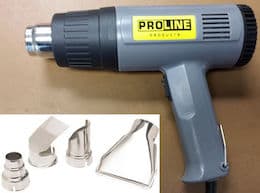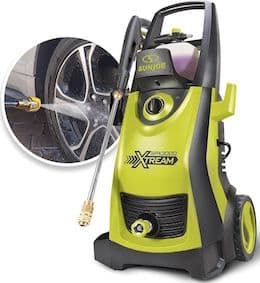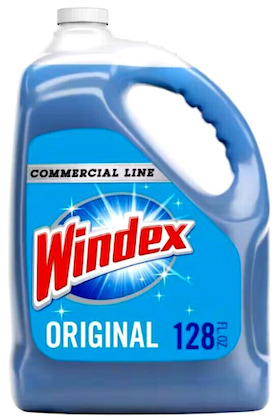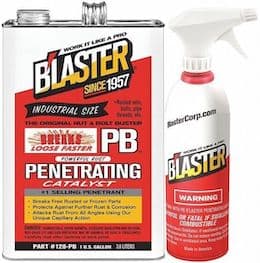
Curated with aloha by
Ted Mooney, P.E. RET

The authoritative public forum
for Metal Finishing 1989-2025

-----
How to remove plastic film & adhesive from stainless steel, brass
Quickstart:
There are different adhesives & situations, but the most successes were reported with hot/boiling water [jump to 1st posting on this] or ammonia [jump to 1st posting on this]. Other non-brand name successes included acetone [jump to 1st posting on this], and heat gun [jump to 1st posting on this] plus a scraper. Many specific name brand products were suggested as well.
Q. Our company manufactures and installs sheet-metal systems for enclosing piping, wiring, etc. in commercial construction. We are presently working with a stainless-steel material that comes from the metal suppler covered with a protective plastic film. This film is removed at the job site after installation. The film is sometimes extremely difficult to remove, often leaving a heavy adhesive residue on the metal. We have tried to remove this residue using MEK, lacquer thinner, xylol_xylene and toluene products, and even gasoline and WD-40. None of these solvents have any significant effect on the adhesive residue. What do we need to remove this residue?
Thanks.
Tech Rep. - San Bruno, California
2003
Ed. note: Several people have recommended that readers proceed immediately to Terry Smith's posting as the simplest solution, and it sounds like something you haven't tried yet.
A. I use "Unseal adhesive releasing solvent". Works great but is very expensive. Active ingredient is Heptane. It is manufactured by Hunt Corporation in Statesville, NC. You can get small container (32 Fl.Oz) from your local picture frame molding supplier. Catalog # 470. I hope it will work for you.
Danny T [surname deleted due to age of posting]Art, framing - Hayward, California
2003
Ed. note: Readers are welcome to look for this product, but we believe the manufacturer's name has changed, and the product name has been changed to "Unstik". It is a hazardous product labeled "For industrial use only", and cannot be shipped except by private truck. We dis-recommend it, and suggest you skip this one.
A. Recently discovered a citrus solution that works wonders: De-solv-it ⇦ this on eBay or Amazon [affil links] made by Orange-sol.

Michael Liu Taylor
specialty stainless steel distributor - Dallas, Texas
2003
HEAT GUN & SCRAPER
|
H |
A. Bill,  Freeman Newton [dec.] R.I.P. old friend (It is our sad duty to advise that Freeman passed away 4/21/12) 2003 A. I have had to remove the plastic film from stainless steel on many occasions over the years so was surprised/happy/delirious when I came across this site suggesting that ammonia would remove the film. Wow, I thought, is this what I have been missing! So I tried it, but alas, it wasn't to be. Actually, I probably would have been pissed thinking about all of the work I could have avoided. - Seattle, Washington August 28, 2009 Ed. note: Tim uses the phrase 'water based', and indeed the stripper can be rinsed with water, but don't infer from this that the material is 'safe'; please check the SDS. A. I have tried for a number of days to come up with a method of removing some of the black and white LDPE film from some carts that were built a few years ago and stored in a location where they saw sunlight. As with most people I tried every solvent I could think of. Then I did some searching and found that Xylene ⇦ this on eBay or Amazon [affil links] at elevated temperatures would penetrate the LDPE. What I found to work was to use a heat gun and warm the metal. Then I soaked a towel in Xylene and placed it on top of plastic and let it sit. After 10-20 min, the plastic coating peeled off as if it were new. Nice and easy leaving no residue. I did get it a little too hot in a few places and melted the plastic fairly severely. But what I found was that by laying the towel over the area second time for a few minutes, the residue wiped right off. Peter Novacek- Menomone Falls, Wisconsin October 29, 2009 A. I can absolutely second the approach taken by Timothy Hicks (described above). - Atherton, California, USA April 29, 2010 A. I figured it out! I just had to remove the film from four elevator doors on a mega million dollar high-rise. It had been left on for four years. The condition was similar to gold flake film with a tar adhesive adhering it to the stainless. It was not fun at the beginning, but I learned the trick to doing it. - Huntington Beach, California, USA October 4, 2011 A. I work at a industrial manufacturing facility that specializes in stainless, and we've had similar problems. Our best solution for getting the blue plastic off is to heat it with a hair dryer style heat gun ⇦ this on eBay or Amazon [affil links] , then wipe the goo left behind with acetone ⇦ this on eBay or Amazon [affil links] Warning! highly Flammable! . Peter Brazil- Port Townsend, Washington, USA August 15, 2013 Ed. note-- Readers: please be aware that acetone is extremely flammable! Don't be misled by previous experience with a nail polish remover with a lot of water mixed in with the acetone! A. Morning, I have a metal roof that the blue protective tape has been baked on. Some will peel off a little. What seems to work the best is a propane torch just enough to melt the tape & adhesive then wipe with a cloth. Just keep moving along & rotate the cloth to a clean area. Caution the tape will be very hot and can stick to and burn your skin. It's time consuming but works! - Crescent City, Florida, USA September 5, 2018 A. I am building my home myself and I installed a stainless steel range hood a couple of years ago and made the mistake of leaving the protective covering on until I was done with the kitchen. The hood had a heavy white plastic covering which I was able to pull off with some effort. The glue that was left behind came off easily with the citrus cleaner Goo Gone
⇦ this on
eBay
or
Amazon [affil links]
. - Phoenix, Arizona February 2, 2013 |
AMMONIA
|
A |
- Port Townsend, Washington 2003
- Paamul, Q. Roo, Mexico 2006 Plastic film on Vermont Castings B-B-Q Grill
- Dallas, Texas 2006
- Stroudsburg, Pennsylvania 2006 Q. I have the same Vermont Casting Grill from Home Depot with the plastic baked on. I tried the ammonia, but did not see the plastic dissolve. I have a feeling that I am not applying it properly. Can someone please let me know how they used the ammonia on their grill. - Sammamish, Washington 2007 A. Hi Dov. Keep reading and Alison MacKenzie's posting explains how she applied the ammonia. Good luck. Regards,  Ted Mooney, P.E. RET Striving to live Aloha finishing.com - Pine Beach, New Jersey A. Bought a new/used stainless steel outdoor refrigerator. Prior owner let the blue plastic film shrink-wrap and melt to the door. Tried everything to remove it. Then found this column. I soaked a washcloth with lemon ammonia and let it set on the door (set horizontal) for 15 minutes. Then used a plastic scraper to scrape away the softened film. Worked great and did not hurt the brushed stainless finish. Thanks! Alison MacKenzie- Poway, California November 22, 2008 ! I didn't get the hoped for melt-away on my Vermont Castings barbecue. After about 40 minutes of soaking via ammonia covered paper towels, however, it was easier to scrape off. I then used non-acetone nail polish to get the glue residue off (didn't have Acetone type). Still have plastic on back side of the hood around small vent holes and don't plan on making myself nuts getting it off. Thanks for all the suggestions, I suspect a lot depends on how long it's been stuck on. Jan C. [surname deleted due to aging of posting]- El Paso, Texas February 7, 2009 ! Read this post, found some household ammonia, used it on the blue plastic on the doors to my new BBQ. The blue stuff just peeled right off. It doesn't just dissolve away. It seems to just loosen the plastic from the steel so that it can be peeled away easier. Start at a corner of the blue, apply a bit of ammonia with a rag and then start peeling. My brother-in-law (who knows everything) stumped. I said I would go check on the net and voila - there was the solution. Thanks all. Pat K. [surname deleted due to aging of posting]- Edmonton, Alberta, Canada August 26, 2010 ! Wow, I couldn't believe it! Was kind of depressed when we opened our dishwasher box, it had been in storage for a year and when we finally got around to installing it I couldn't get all of the wrap (blue) off of it. The wrapper came off but left a residue and smears on the face of the stainless steel door. It looked horrifying. Tried the ammonia and within seconds it was gone. Thanks so much for this suggestion, as I would have had to look at that ugly stain forever as elbow grease just was not taking it off. Carolyn Burke- Kingston, Ontario, Canada November 18, 2011
- Cedar Valley, St. Johns, Antigua December 29, 2012 A. I recently purchased a dishwasher with a stainless steel finish that came wrapped in blue plastic. The plastic came off easily but the imprint of it (14 inches wide) could still be seen on the finish. It wasn't sticky but wouldn't come off with stainless steel cleaner, nail polish remover, or vinegar. However, undiluted household ammonia and some elbow grease removed it completely and left a beautiful finish. Thank you to everyone who suggested ammonia as I would not have thought to try it and it worked! L. Wehrmann- Richmond, Virginia USA February 20, 2014
- Toms River, New Jersey August 25, 2022 |
ACETONE
|
A |
Q. I'm a mason contractor at the NJ shore that built an outdoor stone kitchen area. The homeowners bought and installed small Delfield Refrigerator and freezers that were installed around the stone. Being summer residents, they reminded me to remove the protective plastic coating from the doors as they were not present at the site. Unfortunately I got busy and after a couple of months the sun got to the doors before I could. I was able to peel some of the plastic off, however most has embedded itself where without using solvents it's a millimeter by fingernail process. I haven't tried any solvents except a quick dab with ammonia which did nothing. I'm a bit hesitant to use Goo Gone or Goof Off as a last resort as I'm afraid that I may wipe any protective coating which will induce rust. I need help in direction or products, solvents, heat gun, anything that may work.
Marshall G [surname deleted due to aging of posting]Owner - Long Branch, New Jersey
2007
Plastic film on roofing sheets
Q. Hi fellow sufferers of the accursed plastic cling foil to metal surfaces.
I have the same problem with a corrugated powder coated steel roof.
I have tried acetone, vinegar, domestos, meths, turpentine, petrol (gasoline to North Americans), heat gun, detergent and diluted pool acid to no avail.
The damn stuff is indestructible - any ideas from anyone would be welcome
Thanks to one and all
- Penrith, NSW, Australia
April 16, 2008
Q. I have a painted metal roof where the plastic protective coating has fused to the metal panels. We left the protective coating on thinking we were protecting the roof from contractors who were working on it but didn't realize the work was going to take this long so we left it on too long and now it is almost impossible to remove. The areas that were exposed to the sun are the worst. I have tried warm water, heat gun, ammonia, Goof Off, Goo Gone with no luck. These products will remove the residue where I can remove the plastic -- but for the most part I am stuck with the plastic not being able to be removed.
Nick D [surname deleted due to aging of posting]- Ridgewood, New Jersey, USA
May 22, 2012
⇦ Tip: Readers want to learn from Your Situation 🙂
many readers skip abstract questions.
Q. Please tell me what happens if the plastic cover on the top surface is not removed while installing the sheets on the roof?
Manu N Hegde- Mysore, Karnataka, India
May 28, 2014
? Hi Manu. Are you referring to a plastic protective film?
It's hard to predict consequences ("For want of a nail, the shoe was lost ... "), but perhaps it may create pockets of rainwater that become stagnant and smelly, or accelerate the corrosion. The film is supposed to be removed. And if you don't do it now, Ken warns that it will only get harder :-(
Good luck.
Regards,

Ted Mooney, P.E.
Striving to live Aloha
finishing.com - Pine Beach, New Jersey
Q. UNFORTUNATELY, A LOAF OF BREAD WAS ACCIDENTALLY LEFT ON THE TOP OF OUR STAINLESS STEEL CONVECTION TOASTER OVEN WHILE IT WAS BAKING AT ABOUT 400°F. THE COLOR OF THE BREAD WRAPPER ACTUALLY SEEMS TO BE EMBEDDED IN THE STAINLESS STEEL. I HAVE NOT ATTEMPTED TO CLEAN THIS. SHOULD I USE AMMONIA? OR ANOTHER PRODUCT?
SHARI GUNDY- ST. PAUL, Minnesota
May 28, 2008
Q. I guess I used the stove before taking the blue protective cover off the face of the door, so after a painful time removing it I find a glue cloud mark on the front but I cannot seem to remove it with paint thinner or soap and water.
Dean Waltr- Toronto, Ontario, Canada
June 5, 2008
! Same problem but in my case, I'm a trucker with 6 stainless steel under-storage compartments. I've tried just about everything mentioned above. We truckers like things shiny so I am getting a little p-o'ed with this. Today, I bought a angle grinder ⇦ this on eBay or Amazon [affil links] , a Crossive 6" disc, a hand held buffer as well as buffing compound. I intend to grind this stuff off and mar this finish up then use the compound then buff it out with metal polish. I'll let ya know how it works!
Christopher Bennett- Minneapolis, Minnesota
June 8, 2008
Q. I recently purchased a name brand refrigerator that came with the standard, protective shipping film, that when removed, left an almost invisible residue. You can see it best when you look at the fridge from an angle. The manufacturer says to use soapy water and a sponge...tried that. Didn't work.
Also tried vinegar, ammonia, and orange degreaser. Still nothing.
I have heard to try WD-40, Goo Gone and xylol_xylene. I of course don't want to ruin the finish of the fridge, but would like this residue removed.
Any advice would be appreciated. Thank you.
hobbyist - phoenix, Arizona
May 6, 2009
A. Easy. Use a blowtorch, melt the plastic and wipe off with a cloth. Slow but effective.
Johan Sunpay- Pretoria, South Africa
May 23, 2009
Ed. note: Just a reminder that there are different situations :-)
There may be certain individual items where a torch is applicable, but certainly not on a new refrigerator :-)
Q. We have metal garage doors where the previous owner/builder failed to remove the plastic protective film and it has now sun-baked onto the surface. I have tried a number of solvent based product with no success. I have even tried pressure washing at about 2500 psi 40 degree spread. t took the loose bits off but the majority remains firmly adhered to the painted metal surface. Should I consider just painting over it?
Ken Ines- Vancouver BC Canada
June 30, 2009
A. Yes, I'd say it's unfortunately sounds like it's on for good. Maybe just leave it on and paint with Krylon Fusion for Plastic
⇦ this on
eBay
or
Amazon [affil links]
paint?
Regards,

Ted Mooney, P.E.
Striving to live Aloha
finishing.com - Pine Beach, New Jersey
Q. Would Shellac, Kilz, or Zinsser Cover Stain work in a situation where the plastic coating has baked on to a primed metal door over a 10 year period of time? Which would be the best option.
Thanks
Len
- Abbotsford, B.C. Canada
August 18, 2009
Ed. note: If you've given up on removing the plastic, we think a paint specifically made for good adhesion on plastic like Krylon Fusion for Plastic ⇦ this on eBay or Amazon [affil links] is the best bet.
A. As a vendor of temporary surface protection films, I may be able provide some insights on this topic. Said insights may or may not be of any assistance, depending upon your particular "how-do-I-remove-this-*#^&*%*^-stuff?!" situation.
* The majority (though not all) of the protective films manufactured in the USA, today, are comprised of a water-based acrylic adhesive coated onto LDPE (low density polyethylene) plastic. The white and black films (with the adhesive on the black side) commonly used to protect stainless steel are co-extruded LDPE films. Extruding two thin layers of molten plastic in contact with each other makes a stronger, more abrasion resistant film for the same amount of plastic as one thicker layer.
* Water based acrylic adhesives are pressure, UV light, dwell time and heat sensitive adhesives. The more you have of each of these variables, especially in combination with each other, the "better" these adhesives perform to the point where they won't let go of either the surface being protected nor the carrier film they rode in on. As I believe someone said earlier in this thread, the adhesive and/or plastic becomes "baked" onto the surface. If the surface has a texture that the adhesive can get into, consider it to be twice baked. Though it is slight, brushed stainless steel does have a texture.
* LDPE plastic is non-permeable ... liquids cannot penetrate it. Which is why you can't get your adhesive dissolving agent to work directly on the adhesive.
* LDPE plastic cannot be dissolved by most chemicals. If your liquid adhesive-remover arrived in a plastic bottle, chances are pretty good that that particular liquid isn't going to dissolve a plastic film ;-)
* LDPE won't break down, dissolve or degrade in less than 500 years, except at very high temperatures which would probably cause those few hazardous chemicals that will dissolve it to burst into flames.
* As noted by Tim, stainless steel can be stained and/or discolored. What sometimes appears to be adhesive residue is actually a stain in the steel. Buffing or other treatments may be required to get rid of the stain.
* Other, somewhat specialized, protective films are made with either polypropylene, MDPE, vinyl/PVC or latex saturated papers.
Net-Net: the odds of getting a plastic film to literally dissolve without lots of applied heat, are not in your favor. Concentrate on finding a [mechanical] method of removing the film then address the adhesive mess that got left behind.
- Rockwall, Texas
September 9, 2009
Q. Hey Everyone,
Looks like we've all be scratching our heads on how to remove the 'baked on' plastic film. Mine issue is what Rick P from Texas called "twice baked'. I too bought a house where the previous owner had installed an insulated white finished steel wood grained look of a garage door where the previous owner listened to installer and his suggestion to "leave on the plastic film as it will just protect the doors finish"! What a crock.
I'm now left with this huge double garage door with a cracked, dirt filled plastic shell finish that seems to be bomb proof. I have tried the orange stuff, nail polish remover, gasoline, cooking oil, heat gun (started to damage the surface), wonderwheel (Automotive pinstripe remover, which just smeared the plastic) and finally ammonia. Nothing has worked. The manufacturers of the door don't even know what to do, other than tell me that the guy should have removed the film on installation. I'm at my wits end with this project, but will not give up. There has to be an answer with this. Ammonia only cleans the surface, but the plastic is still there, and as tough as nails, it's just cleaner! So someone PLEASE HELP with an answer. This is MAJOR double baked!
home owner - Oakville, Ontario, Canada
September 23, 2009
A. Hi Chris,
I've said this before but if the plastic won't come off but you don't like the look, it may be time to paint it :-)
Luck & Regards,

Ted Mooney, P.E. RET
Striving to live Aloha
finishing.com - Pine Beach, New Jersey
Film on brass kickplate
Q. Can I try all these same methods on a brass kick plate that the film has been left on for many years, or would some of these products damage the brass finish?
MARCIA OLSON- Auburn, Washington
October 1, 2009
Q. I am writing to try to help my husband who is a contractor and is having a hell of a time trying to clean new polished brass door kick plates for one of his customers. When he was ready to install the kick plates, he peeled off a protective film from the brass. When he did this, the brand new plates looked discolored and it seems as if some of the protective coating was left on the brass. We cannot get the residue off and we are concerned about ruining the polished brass surface with cleaners. If someone has suggestions, we would really appreciate it and so would his customer.
Sarah PolselliContractor - San Diego, California, USA
October 27, 2010
A. NO AMMONIA ON BRASS
A word of warning when using ammonia. Do not use it on brass. It will turn brass as black as the inside of your hat. I learned the hard way when trying to remove the film from brass name plates that were to be etched.
- Lexington, Ohio, USA
A. Hi, Sarah. Brass tarnishes quickly, so there is no way it stays polished unless it is protected with a lacquer or other clearcoat. So this is trickier than some of the other problems. Try lacquer thinner
⇦ this on
eBay
or
Amazon
[affil links] Warning! flammable!
; they should remove the gunk and the lacquer, if it is in fact lacquer. Then redo the brass lacquer
⇦ this on
eBay
or
Amazon [affil links]
.
Regards,

Ted Mooney, P.E.
Striving to live Aloha
finishing.com - Pine Beach, New Jersey
Q. How can I remove plastic type cover from stainless steel door panels? It had dried out and stuck like paint over the time.I appreciate any suggestions.Thank you all. Jorge G.
Jorge Gallegoelevator tech. - New York City, New York
April 6, 2010
A. My daughter had a product that removed Artificial Nails by dissolving the glue .
I tried this with a cotton pad, the glue residue dissolved VERY easy ... 10 out of 10
- Northampton, England
April 11, 2010
PRESSURE WASHER
|
P |
A. Had the same problem with the protective coating on aluminium composite panels that had been exposed to the African sun for about 10 months. Tried all the suggestions with no luck. Eventually had success with a pressure washer ⇦ this on eBay or Amazon [affil links] . Chris Bode- East London, South Africa April 20, 2010 A. The company I work for is a new commercial truck dealer. When we get new Mack trucks in from the factory the aluminum fuel tanks are covered with a protective film. The film is almost like a powder coating or Rhino lining in texture and durability, more so the longer it stays on and exposed to the sun. We have struggled with removal techniques but it seems like the most effective and least time consuming is a HOT pressure wash. Sidney Dotson- Knoxville Tennessee August 27, 2014 |
Q. Hi! I have the same problem as many of you do. I bought a used kayak Aluminum pool that had plastic coating on it. It was stored in the heat and I cannot remove the plastic film. I have tried solvents with no luck. Can someone please help me. Will heat ruin the aluminum? Thanks for any help..
Susie Dicerbohomeowner - Harrison Township, Michigan, USA
April 26, 2011
A. You might try a gas fired catalytic heater ⇦ this on eBay or Amazon [affil links] . They do not give the intensive heat of heat guns. Their face temperatures can be adjusted from 350 °F to 900 °F. The heat is medium rays infrared.
Dave Howie- Edmonton Alberta Canada
May 9, 2011
BOILING WATER / STEAM
|
B |
A. Okay kids ... this is the deal: We just boiled some water in a tea kettle and poured it on the doors of the outdoor gas BBQ, and presto, the blue film peeled off in a flash. Taking off the residue in addition to the film. Easy and free!! Terry Smith- Seattle, Washington June 17, 2011
- Auckland, New Zealand July 28, 2011 A. This worked very quickly and very efficiently: - Toronto Canada
- Raetihi Ruapehu, New Zealand March 31, 2013
- Norcross, Georgia, Gwinnett February 12, 2015 A. It works like a charm, you have to work quickly as the film will cool and adhere to the metal. Wearing leather gloves, I poured the heated water as I removed the film. As it cools, don't tear the film off completely so you can continue pulling the film as you apply the next batch of hot water on the surface. It's easier with 2 people but I did it myself. The white film that remains can be cleaned with Windex Commercial Line ⇦ this on eBay or Amazon [affil links] or ammonia. Linc Lucer- Seal Beach, California, USA July 14, 2015 A. Best solution I have found so far is a plain household steam cleaner
⇦ this on
eBay or
Amazon [affil links]
with a plastic scraper. I'm removing the wood effect from the sandwich board in a sliding gate. Tried chemicals and a blow torch (which baked it on harder). - Málaga April 23, 2023 |
Q. How would you get rid of the adhesive on the back of a combination lock?
- St. Catherines, Ontario, Canada
August 9, 2011
Q. When our stainless refrigerator was delivered it had a protective blue plastic covering on to prevent scratching. We were in the process of renovating and left the plastic on for several months and now have marks that won't come off with stainless steel appliance cleaner. Please let me know what to use to get these marks off?
Debra BrownPurchaser - Seven Valleys, Pennsylvania
October 10, 2011
Q. We had some plastic auto body painters sheeting that got stuck to a surface that wasn't quite cured. Is there any solvent that would melt that sheeting without damaging the paint too much? Or does anyone know what kind of plastic that sheeting is?
Jeff ReimerIndustrial painter - Alberta, Canada
December 1, 2011
 Hi, Jeff.
Hi, Jeff.
I don't think there is a chance in a million of removing that sheeting without ruining the paint (in fact the paint may already be ruined, pushed down or pulled up). But I am not a painter and would certainly love to hear that I was wrong. The plastic is probably a polyolefin or vinyl, very chemically resistant anyway.
Regards,

Ted Mooney, P.E.
Striving to live Aloha
finishing.com - Pine Beach, New Jersey
 O.M.G. my whole day so far has been trying to get a clear film off of a white metal shed door. Once again, we thought the plastic was protecting the door until all work other around it was finished - which ended up being a total of about 3 years.
O.M.G. my whole day so far has been trying to get a clear film off of a white metal shed door. Once again, we thought the plastic was protecting the door until all work other around it was finished - which ended up being a total of about 3 years.
I have tried the boiling hot water, a warm water and soap soak using towels to keep it soaking, Glass Plus, Green Works, ammonia, paint thinner, rubbing alcohol. Nothing was going well at all so I went to town and purchased a heat gun this afternoon. No help. I am seriously thinking of just buying and installing a new door. The companies that sell plastic coated items should have to tell you that you do need to remove the coating right away or post a big warning sign on them about the protective seal. This is over the top annoying & frustrating and I feel like crying.
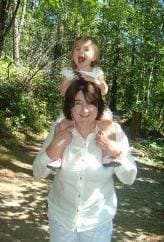
Joanne Chase
- Port Alberni, B.C., Canada
July 8, 2012
A. I bought a stainless steel dual-fuel range for my wife for about half the price of a new model. Someone had purchased it years earlier and never peeled off the protective plastic and never installed it. I was really frustrated trying to remove the plastic bit by bit scraping with my fingernail, until I discovered a great method.
I started to use my fingernail in the center of a patch of plastic instead of the edge. It turned a brighter shade of white. At first I just thought I might have just scratched the surface but then realizes that scraping on the plastic actually broke it free underneath. Once you see the bright white appear, you can work it all the way to an edge.
My wife saw what I was doing and grabbed a plastic spoon that worked much better than a fingernail. Do not use it to try to scrape like a putty knife, use it to stretch the plastic from the center and break the bond at the surface. Once you turn everything bright white, you can peel the sheet off in one piece.
I still have to deal with the adhesive residue that is left behind, but after reading about the methods others have written about here, I don't think that will be a problem.
- Lock Haven, Pennsylvania
December 25, 2012
A. I had similar problem (protective plastic film "welded" to s stainless steel gas patio heater), but none of the solutions here worked. The plastic film was completely impermeable to the solvents I tried. Damn.
At another site, www.surfacearmor.com/faqs.html ⇩, I found that my problem film was "probably LDPE, which is low density polyethylene. And, the adhesive is probably a water-based acrylic".
Fair enough, but their solution involved sand papering the surface to expose the glue.
My solution was to attack the plastic with a paint stripper (bad, bad -- but it worked). I used 870 g/L dichloromethane, sold in Oz as Selleys Kwik Strip. Care and timing was needed (there were other plastic and rubber components around). A thick coating, left for 8-10 minutes, let me remove the gunk with a plastic spatular in large strips within 5 minutes (after that the plastic hardened).
Moral? Think laterally -- and be careful.
- Windaroo, Queensland, Australia
May 4, 2012
Ed. note: Dichloromethane, maybe better known in the U.S. as methylene chloride, is a truly toxic paint stripper. If you find and use it, make sure you are wearing rubber gloves ⇦ this on eBay or Amazon [affil links] and goggles ⇦ this on eBay or Amazon [affil links] ; you should also wear an activated carbon respirator ⇦ this on eBay or Amazon [affil links] and work outdoors from upwind.
The above link is broken. Thankfully, the Internet Archive preserved a copy here
These days information often appears on the internet, then disappears forever. If that is a concern to you please consider a donation to The Internet Archive.
![]() Success! After reading this column, I figured I would try Citric solvent, ammonia, acetone and Goof Off (in that order) to remove the blue cellophane from a nice stainless microwave some friends gave us. They had used it for a while without removing the protective file, and it was hopelessly stuck and leaving a gluey residue. We happened to have a bottle of Orange TKO
⇦ this on
eBay or
Amazon [affil links] "super concentrated cleaner", and it worked like a charm.
Success! After reading this column, I figured I would try Citric solvent, ammonia, acetone and Goof Off (in that order) to remove the blue cellophane from a nice stainless microwave some friends gave us. They had used it for a while without removing the protective file, and it was hopelessly stuck and leaving a gluey residue. We happened to have a bottle of Orange TKO
⇦ this on
eBay or
Amazon [affil links] "super concentrated cleaner", and it worked like a charm.
It did NOT work instantly. I had to pour the orange concentrate on the remaining blue plastic, spread it around, and wait for a few minutes. Then, using a paper towel soaked in the cleaner, my thumbnail would easily scrape the plastic off. It even started coming off in sheets (like it was supposed to) after soaking for a little longer. I still had to scrape with my fingernail through the soaked paper towel to get some stubborn parts off, but it was spotless after 15 minutes of work.
- Berkeley, California
2009
Q. How can I remove melted rubber (gloves) off of an appliance.
Patricia McGowanhouse wife - Odenton, Maryland, US
January 16, 2013
A. Hi Patricia. What kind of appliance and what finish? Paint, porcelain, stainless steel, aluminum, ceramic, glass? It may be impractical or impossible, but you might take a look at topic 14006 "Melted Rainsuit on Motorcycle Exhaust Pipes" and see if you think it might help.
Regards,

Ted Mooney, P.E.
Striving to live Aloha
finishing.com - Pine Beach, New Jersey

A. Short answer = Product name in Australia LIQUID 8 (paint stripper gel)
Long answer...
I had same problem with a stainless steel fridge. Tried MEK, Acetone, Ammonia, Sulfamic Acid, citric acid the list goes on all with no effect. Was ready to resign to scratching and picking away
I then remembered I had a paint stripper gel which I 'thought' was citric acid based (was told that when I bought it) but the ingredients are 180 g/L Liquid Hydrocarbon / 180 g/L 2 Butoxy Ethanol and 180 g/L N-Methyl-2-Pyrrolidone. The product is called LIQUID 8.
Brushed on the gel and left for recommended 15-30 minutes and although not great results I could see it was working. Left it another 30 minutes and the plastic film literally wiped away. A few little tougher spots took a second go but what had taken me most of a day trying came down to being all done in about and hour and a half and most of that time was waiting for the gel to do its stuff.
One thing to note this stuff is not kind to plastics so keep it off any trim etc, I accidentally hit a couple spots and some minor burn marks.
- Western Australia, Australia
February 11, 2013
A. 5 words: Jasco Paint and Epoxy Remover
⇦ this on
eBay or
Amazon [affil links]
I tried everything above. Bought a island kitchen hood on eBay new only installed. They didn't say they left the plastic on for a year in the sun. White film , I spent 3 hours using vinegar, acetone, ammonia, heat gun and plastic spoon. Jasco brushed it on waited 10 minutes and peeled it off with my hands; no big mess. Wiped down and I have a beautiful Stainless hood which would have cost $600 for $200.
- aurora, Colorado
February 23, 2013
A. I'd like to take time to respond about white PVC plastic protective covering on stainless steel. When we get equipment that PVC covering has not been removed in years, take it outside, hook your garden hose to hot water, adjust your nozzle to jet. Now wear rubber gloves with cotton gloves under the rubber gloves. Maybe you need to wear a rain suit -- you will get wet. Remember this water is hot; wear goggles. Start spraying one spot for a few seconds until it loosens up.
When your start peeling off PVC, keep hot spraying while you are doing this. It will take time; you can go to a self operated car wash if they have hot water. Have fun.
food equipment - Runnemede, New Jersey
April 15, 2013
Q. I am a superintendent at my construction company and have "built out" three floors of an occupied building. Upon entering the final cleaning phase, I noticed that the white and black protective film on the stainless steel elevator doors was never removed since original construction some 5 years ago. I can't seem to get it off and need to be able to use a low V.O.C. agent due to the existing occupancy. HELP!
Victor Terwilligerconstruction - Norfolk, Virginia
June 17, 2013
A. DENATURED ALCOHOL
The item you want to use to remove adhesive off stainless or other items is denatured alcohol
⇦ this on
eBay or
Amazon [affil links]
, then Windex Commercial Line
⇦ this on
eBay or
Amazon [affil links]
with a microfiber cloth
⇦ this on
eBay
or
Amazon
[affil links]
on stainless.
- golden valley Arizona
July 7, 2014
A. I removed the glue residue from my stainless steel fridge with Brasso ⇦ this on eBay or Amazon [affil links] . It took it right off and I tried about everything.
Brian roche- Villa rica Georgia USA
July 28, 2014
A. I purchased a used stainless steel BBQ and discovered that on the back of it, the previous owner didn't bother removing the plastic cover which of course was now baked on. It took 3 days of about 2 hours per day and most of it is now gone. What I did was the following:
1. Get extra strength Easy Off oven cleaner
⇦ this on
eBay or
Amazon [affil links] (Lye)
2. Heat up the surface, in my case I use a heat gun initially, but then turned on the BBQ
3. Spray Easy Off on the surface, wear a mask, the fumes are nasty
4. Let sit for about 10-20 min
5. User a hard plastic spatula to remove the residue, also wet rag after (get a bag of them at Lowes/HD)
6. You'll need to repeat this multiple times based on how much stuff there is baked on.
This was a PITA, I still have a little bit remaining, but it is mostly clean.
- Los Angeles, California
December 12, 2014

A. The best method to use is a torch, assuming there's no material adjacent or under the stainless steel that will be harmed by the heat.
You can still use a torch if there's something next to the stainless that can't get too hot, but you have to work fast and don't go beyond liquefying the plastic you're trying to remove.
Yes, basically I'm saying you're liquefying the plastic and wiping it off while it's still fluid. Following is an image of me removing plastic film with a torch that had been on an item that was outside for 14 years!
Restaurateur and tradesman - Lancaster, California
Remove sun-baked vinyl packaging from garage door
Q. I left the cellophane plastic on garage door (vinyl) allowed it to be baked in sun ... now difficult to remove. Need guidance as to any solutions or technique.
Len zap- indio California usa
May 25, 2014
Q. I recently bought a car that has a film over the plastic lens cover of the headlight.
According to a local here, some folks put glass darkening film over the plastic headlight cover to look "hot".
While it may look "hot" , but at night it darkens the head light so you do not see the road well.
Have taken it to a paint shop and they said they could do nothing, then took it to a glass shop and that does darkening film on glass windows here in the desert and they said they did not know what to do. But it is a film and being a plastic, most are scared of touching/trying to remove since the base is a also plastic and they think they may scratch the lens cover.
Any help?
bob
private indiv. - palm springs, calif, USA
December 26, 2014
Q. I built my own house. It took three years and at the end of the first year I had installed my patio doors. Two years later, I've found that the plastic film covering the glass on the doors had baked on. Scraping doesn't budge it. I'm very reluctant to use a heat gun or boiling water as the glass might crack. any ideas?
Victor Damski- Lowestoft Suffolk UK
February 24, 2015
A. Hi,
You can try nail polish remover, or ethyl acetate. Wipe the edges of the film and when the adhesive layer weakens, shoot and so on.
- Moscow, Russia
July 28, 2015
Q. I never removed the protective film off my outdoor french doors. they baked in the sun and I removed the plastic but the residue has remained and I tried to remove it with goop removal a very little came off only after rubbing it for a very long time. Is there anything else I can do to remove this sticky residue? Thanks
Phil spadafora- dix hills New York
August 16, 2015
Q. We remodeled our home and had a SS Viking range and hood installed. The contractor did not take the plastic white film off from the underside or sides of the hood. We are slowly peeling it off but now that the hood has already been installed it's a nightmare! The boiling water idea sounds great but there's no way to pour boiling water onto something you're trying to clean upside down. We have to be in the most contorted positions just to work at it a little. To compound the problem the film seems to go underneath the edges of the trim and light sockets so even when we get the film off to that point, it won't budge. We're worried about using acetone etc. since it's above where we cook and difficult to see where we're applying it and then cleaning it off. Any thoughts about removing this stuff after the SS piece has already been installed?
Annie Wilkinson- Layton, Utah, U.S.A.
September 12, 2015
A. So you've finally peeled the old film off of your stainless appliance, only to find an immovable film of glue left behind.
Ran into this after waiting over a year to peel a fridge in our showroom. Tried everything (including the bottle of Rye in the back) to no avail, everything just smeared the glue! Then the old grey cells suddenly jumped back to life (could of been all of the cleaners that I had inhaled) and I remembered that brake fluid
⇦ this on
eBay
or
Amazon [affil links]
removes paint (amongst other things). Gave it a try and much brake fluid and many paper towels later my 36" x 84" fridge now gleams. Caution, brake fluid will dissolve plastics!!! Mask off any plastic that may come into contact with the Brake Fluid!!! Give it a final wipe down with rubbing alcohol and you have a very clean and shiny fridge or other stainless appliance.
- Calgary, AB, Canada
October 17, 2016
A. We just had success removing some of that stuck on thin blue plastic wrap from a new range that had been delivered months ago but just was installed last week. It had been stored in an untested porch 15 below zero. Most of the plastic peeled off in sheets ok , although very slowly, but some was really stuck on. We tried Simple Green, which was recommended by the installer (it didn't work) and acetone (nail polish remover, didn't work either). I was on my way to the hardware store to buy some ammonia and whatever else looked interesting (per this blog) when my wife called from home to say she had removed all the plastic with a hot hair dryer and a scrub sponge. I had mentioned before I left to the store, that someone had successfully used a heat gun. Well didn't have one of those but she used what we had. Short story made long. Try a Hair dryer.
Patrick Murphy- Enosburg Falls, Vermont, USA
April 9, 2017
A. As for removing the glue after removing the sheeting, use mineral spirits ⇦ this on eBay or Amazon [affil links] or Zep stainless steel polish ⇦ this on eBay or Amazon [affil links] ; it also makes it shine
Ricky Gee- mt. sterling, kentucky
August 30, 2017
A. I had purchased an aluminum fender for a car trailer with old sun beaten blue plastic film that came off in small fragments. After reading this site I SOLVED the problem: I used paint remover gel ⇦ this on eBay or Amazon [affil links] , let it sit for ten minutes, and scrubbed it off with a soft bristle brush. Worked like magic.
Doug jones- Milwaukee Wisconsin
June 7, 2018
A. Peanut butter more specifically the oil that floats on top of natural peanut butter will remove all adhesives naturally and cheap!
Belinda Lovins- Thornton Colorado
July 25, 2018
Q. I have an outdoor grill that has been in Texas heat for few years with "laser film" white covering. I tried applying ammonia, nail polish remover and scrapping it, but no luck getting it out.


- Southlake, Texas, USA
May 5, 2020
A. Blue film on dishwasher would not come off with heat gun. I had a can of "penetrating catalyst" ⇦ this on eBay or Amazon [affil links] , used to remove rusted bolts) and it worked beautifully. Spray on and let sit. Spray again. wait. Peel from edge.

- Dallas, Texas, USA
May 25, 2020
Q. How to old remove ACP plastic protection film from fibre sheet door?
- Delhi new delhi
October 16, 2022
Ed. note: Can you tell us what ACP means in this context please?
A. Best way, fast and cheap is plain old gasoline. It dissolves PVC in a matter of minutes. Works on old stainless steel that was exposed to conditions.
Vlad ProdanLaser operator - Cluj-Napocs, Romania
October 4, 2023
Ed. note: Obviously, gasoline is dangerous so don't even think about bringing it into a house.
If you're still not weary, thread 30965 offers yet more ideas :-)
Q, A, or Comment on THIS thread -or- Start a NEW Thread

